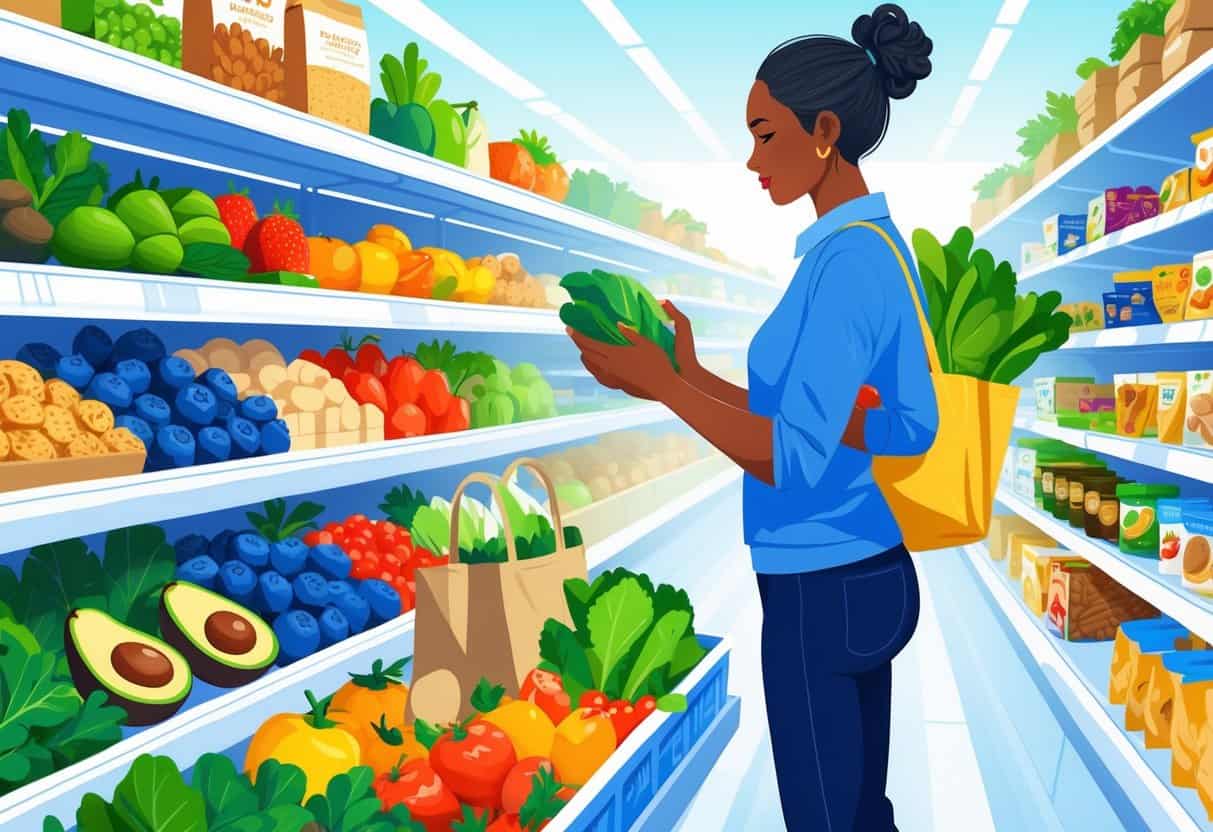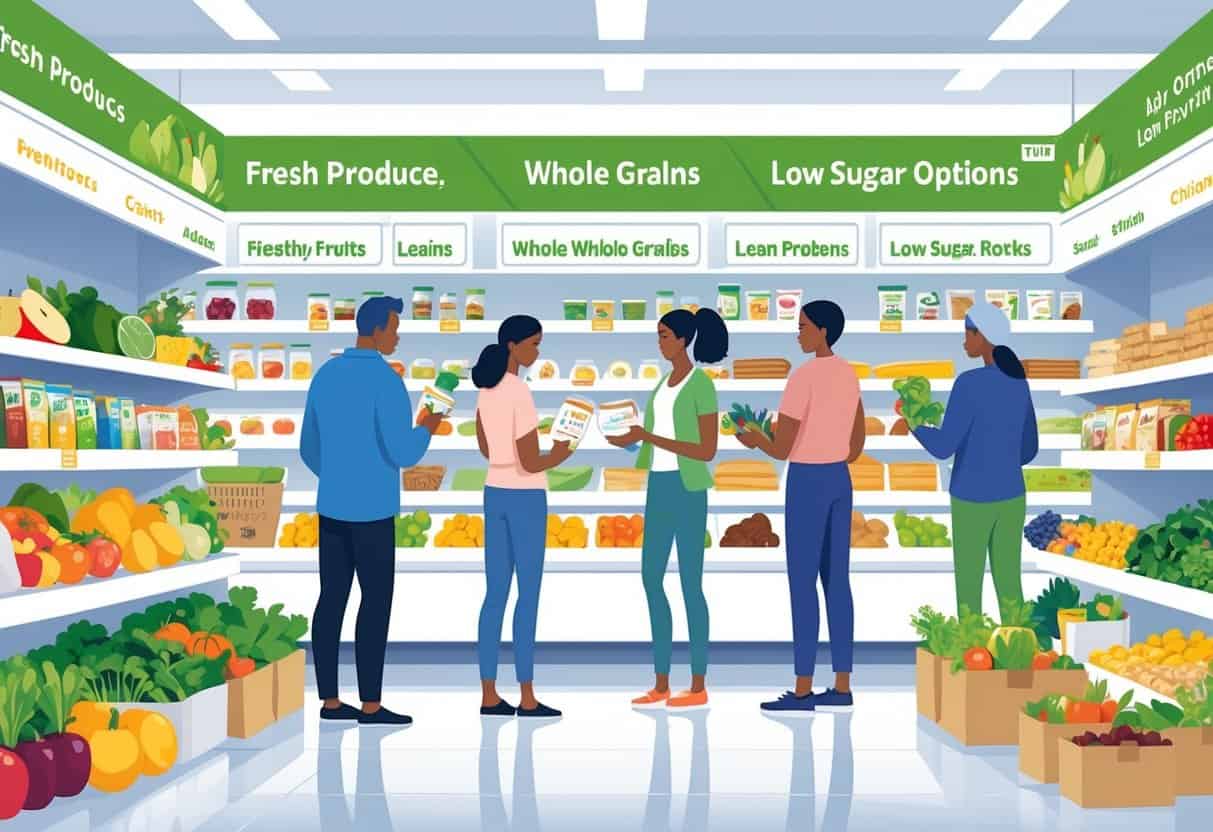Grocery shopping with diabetes can feel like a lot, but honestly, it doesn’t have to be. The trick is to pick foods that help keep your blood sugar steady and steer clear of those that send it soaring.
Knowing what to look for—and planning ahead—makes it way easier to make better choices without all the hassle.

Making a grocery list and actually sticking to it? That’s a game-changer for avoiding those impulse grabs that don’t do your health any favors.
Try shopping after you’ve eaten, and always give those food labels a second look.
Even small tweaks in your shopping routine can really help you keep blood sugar on track.
When you know which foods to include and which to skip, you’re in the driver’s seat with your diet.
With a handful of simple tips, your next grocery run can actually support your diabetes management—without making you feel boxed in.
Key Takeways
- Choose foods that support steady blood sugar levels.
- Plan your grocery list to avoid unhealthy impulse buys.
- Read labels and shop with a clear goal in mind.
Understanding Nutritional Needs for Diabetes

Managing your diet is honestly one of the biggest pieces of the diabetes puzzle.
You’ve gotta know which nutrients mess with your glucose and how to balance them.
Carbs, fiber, and basic nutrition—these are the things to pay attention to if you want to make smarter choices.
Importance of Nutrition
Your body needs the right nutrients to function and keep diabetes in check.
A balanced diet helps you dodge those wild blood sugar swings.
Stick to real, whole foods—think veggies, lean proteins, and healthy fats.
Cut back on added sugars and processed stuff, since they can spike blood sugar fast.
Nutrient-rich foods give you more energy and just make you feel better overall.
Carbohydrates and Blood Sugar
Carbs are the main thing that affect your blood sugar.
Your body breaks them down into sugar, which then hits your bloodstream.
But not all carbs are created equal.
Go for whole grains like brown rice or oatmeal, not the white bread or white rice.
Whole grains release sugar more slowly, which helps you stay in control.
Keep an eye on your portion sizes, and try to spread carbs out during the day.
Role of Fiber in a Diabetic Diet
Fiber is your friend—it’s in fruits, veggies, beans, and whole grains.
It slows down digestion and sugar absorption, which helps keep blood sugar steady.
Focus on foods high in soluble fiber, like oats, apples, and carrots.
Fiber keeps you full longer, too, so you’re less likely to overdo it at meals.
Planning Your Grocery List as a Diabetic
Your grocery list should back up a meal plan that keeps your blood sugar even.
Pay attention to portion sizes so you don’t end up eating more carbs or calories than you meant to.
Picking the right foods and serving amounts really makes a difference.
Building a Balanced Meal Plan
Start with lots of non-starchy veggies—spinach, broccoli, peppers.
Fill up half your plate with those for fiber without spiking blood sugar.
Add lean proteins like chicken, fish, or tofu to help you stay full.
Whole grains are better than refined ones, so pick brown rice, quinoa, or whole wheat bread.
Plan meals with a mix of carbs, protein, and fat.
Having a weekly list of these foods can help you shop faster and make fewer last-minute bad choices.
Choosing the Right Serving Size
Serving size is huge when you’re managing diabetes.
Even healthy foods can push up your blood sugar if you eat too much.
Use measuring cups, food scales, or just eyeball it—a fist is about a cup.
Carbs need extra attention.
Try to keep portions consistent at each meal to avoid spikes.
For example, ½ cup cooked rice or one small piece of fruit is a serving.
Snacks count, too—nuts, yogurt, or raw veggies are solid options, but don’t go overboard.
Keeping servings steady just makes blood sugar easier to handle.
Smart Shopping Strategies
Managing diabetes means being smart about what you toss in your cart.
Knowing what to look for on labels and getting advice from a pro can make a real difference.
Reading Nutrition Labels
Always check nutrition labels.
Look for total carbohydrates and added sugars—these are the main things that affect your blood sugar.
Pay attention to serving sizes so you don’t end up eating more carbs than you planned.
Ingredients are listed from most to least.
If sugar is near the top or there’s a bunch of weird additives, maybe skip it.
Fiber is good—pick items with more of it, since it slows sugar absorption.
Here’s what to keep an eye on:
| Nutrient | What to Do |
|---|---|
| Total Carbohydrates | Count carbs for meal planning |
| Added Sugars | Choose foods low in added sugars |
| Fiber | Pick foods high in fiber (5g or more) |
| Sodium | Keep sodium moderate for overall health |
Reading labels saves you time and guesswork—and helps you pick foods that fit your diabetes plan.
Working with a Registered Dietitian
A registered dietitian (RD) can be a lifesaver for grocery shopping and meal planning.
They get diabetes and can help you come up with a plan that works for you.
Tell your RD about your usual eating habits and what’s available at your store.
They’ll have suggestions for smart swaps and how to decode those tricky labels.
RDs can teach you how to balance carbs, protein, and fat for your needs.
They’ll help you plan meals that work for your blood sugar goals.
Meeting with a dietitian means less stress and more confidence at the store.
Selecting Healthy Foods
Picking the right foods helps you manage blood sugar and feel better overall.
Focus on foods that give steady energy and avoid spikes.
Lean proteins and certain fruits are your friends here.
Identifying Lean Protein Sources
Lean protein keeps you full and helps your muscles—without loading you up with extra fat.
Look for skinless chicken, turkey, fish, and lean cuts of beef or pork.
Plant-based proteins like beans, lentils, and tofu are great, too.
Skip fatty cuts of meat and processed stuff like sausages or bacon—they’re not doing you any favors.
Yogurt is a good protein pick, especially plain, low-fat, or Greek yogurt.
It’s got protein and can help your digestion, without piling on the sugar.
Picking Fruits Best for Blood Sugar Control
Not all fruits hit your blood sugar the same way.
Go for ones with a low glycemic index (GI)—blueberries, strawberries, apples.
They’ve got fiber and antioxidants, which is a nice bonus.
Stay away from fruit juices and dried fruits—they’re loaded with sugar and can spike your blood sugar fast.
Fresh, whole fruits are the way to go.
Keep your portions in check, too.
A half-cup of blueberries or one small apple is usually a good serving.
Avoiding Problem Foods
When you’re shopping, try to limit added sugars, pick foods low in saturated fat, and watch the sodium.
This helps with blood sugar, heart health, and blood pressure.
Processed foods are usually the worst offenders, so watch out for those.
Limiting Added Sugars
Added sugars can send your blood sugar through the roof.
Steer clear of foods with corn syrup, sucrose, or maltose on the label.
Check packaged snacks, sauces, and drinks carefully.
Go for plain or lightly sweetened options.
Pick unsweetened yogurt or fresh fruit instead of sugary desserts.
Skip sodas, energy drinks, and sugary juices—they’re just sugar bombs.
A solid shopping list can help you avoid grabbing sugary snacks on a whim.
Try to make water, tea, or black coffee your main drinks.
Less added sugar makes diabetes easier to manage.
Choosing Foods Low in Saturated Fat
Saturated fat can raise your bad cholesterol and your risk for heart problems.
Pick lean proteins like chicken breast, fish, or tofu instead of fatty meats.
Processed foods—sausages, hot dogs, packaged baked goods—usually hide a lot of saturated fat.
Look for products with less than 5 grams of saturated fat per serving.
How you cook matters, too.
Bake, grill, or steam instead of frying.
A little olive oil is a better choice than butter or lard.
Reducing Sodium Intake
Too much sodium can raise your blood pressure, which isn’t great if you have diabetes.
Processed foods like canned soups, frozen meals, and salty snacks are usually loaded with sodium.
Pick fresh or frozen veggies without added salt.
When you buy canned stuff, look for “low sodium” or “no salt added” on the label.
Use herbs and spices to add flavor instead of reaching for the salt shaker.
Try to keep sodium under 2,300 milligrams a day.
Reading every label helps you keep track.
Cooking at home gives you more control over how much salt ends up in your food.
Healthy Grocery Staples
When you’re shopping for diabetes-friendly foods, go for things that help control blood sugar and give steady energy.
Pick foods high in fiber and nutrients, and skip the added sugars and refined carbs.
Best Fiber-Rich Staples
Fiber slows down sugar absorption, which helps keep blood sugar stable.
Stock up on these high-fiber foods:
- Whole grains: Brown rice, quinoa, oats, whole-wheat pasta
- Legumes: Beans, lentils, chickpeas
- Vegetables: Leafy greens like spinach, kale, collard greens
- Fruits: Berries such as strawberries and blueberries; they’ve got fiber and less sugar
Fiber keeps you full longer, so you’re less likely to overeat.
Go for fresh or frozen options without extra sauces or sugar.
Skip processed grains and sugary cereals—they’re just not worth it.
Essential Items for Nutrient-Dense Meals
Go for foods loaded with nutrients but low in added sugars or unhealthy fats. That means things like lean proteins, colorful veggies, and fruits that aren’t overly sweet.
- Lean proteins: Think skinless chicken, turkey, tofu, or maybe some salmon if you’re into fish.
- Vegetables: Salads with leafy greens, bell peppers, cucumbers—honestly, the more color, the better.
- Fruits: Fresh berries are a solid pick, or maybe a few slices of apple or pear if you want something sweet without overdoing it.
It’s smart to keep your pantry stocked with these basics. They’ll make it a lot easier to throw together meals that actually support your health.
Try to skip processed foods and sugary snacks when you can. It’s not always easy, but your blood sugar will thank you.